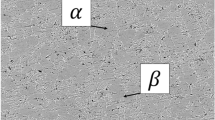Abstract
Coolant supplied by high pressure into the cutting zone has shown the lower thermal loads on the tool when machining difficult-to-cut materials as the Alloy 718. In this study, we investigate how the combination of high-pressure cooling and tool–surface modifications can lead to further improvements regarding tool life. The general approach is to enhance the coolant–tool interaction by increasing the contact area. Therefore, we machined cooling features into flank and rake faces of commercially available cemented tungsten carbide inserts. In this way, the surface area was increased by ~ 12%. After the cutting tests, the tools were analyzed by scanning electron microscopy combined with energy-dispersive X-ray spectroscopy. Compared with conventional tools, the tool modifications reduced the flank wear by 45% for the investigated cutting parameters. Furthermore, we were able to significantly increase the cutting speed and feed rate without failure of the tool. The investigated surface modifications have great potential to enhance the productivity of metal cutting processes.
Similar content being viewed by others
References
Choudhury, I. A. and El-Baradie, M.A, Machinability of nickel-base super alloys: a general review, J. Mater. Process. Technol., 1998, vol. 77, nos. 1–3, pp. 278–284.
AB Sandvik Coromant Heat resistant super alloys, Application guide, 2010.
M’Saoubi, R., Axinte, D., Soo S.L., et al., High performance cutting of advanced aerospace alloys and composite materials, CIRP Annals–Manuf. Tech., 2015, vol. 64, no. 2, pp. 557–580.
Ezugwu, E.O. and Bonney, J, Effect of high-pressure coolant supply when machining nickel-base,Inconel 718,alloy with coated carbide tools, J. Mater. Process. Technol., 2004, vol. 153, no. 1, pp. 1045–1050.
Krämer, A., Klocke, F., Sangermann, H., and Lung, D, Influence of the lubricoolant strategy on thermo-mechanical tool load, CIRP J. Manuf. Sci. Technol., 2014, vol. 7, no. 1, pp. 40–47.
Klocke, F., Sangermannk, H., Krämer, A., and Lung, D, Influence of a high-pressure lubricoolant supply on thermo-mechanical tool load and tool wear behavior in the turning of aerospace materials, Proc. Inst. Mech. Eng. Part B J. Eng. Manuf., 2011, vol. 225, no. 1, pp. 52–61.
Ezugwu, E.O. and Bonney, J, Finish machining of nickel-base Inconel 718 alloy with coated carbide tool under conventional and high-pressure coolant supplies, Tribol. Trans., 2005, vol. 48, no.1, pp. 76–81.
Klocke, F., Lung, D., Cayli, T., et al. Evaluation of energy efficiency in cutting aerospace materials with high-pressure cooling lubricant supply, Int. J. Precis. Eng. Manuf., 2014, vol. 15, no. 6, pp. 1179–1185.
Sugihara, T. and Enomoto, T, Crater and flank wear resistance of cutting tools having micro textured surfaces, Precis. Eng., 2013, vol. 37, no. 4, pp. 888–896.
Kawasegi, N., Sugimori, H., Morimoto, H., et al., Development of cutting tools with microscale and nanoscale textures to improve frictional behavior, Ibid., 2009, vol. 33, no. 3, pp. 248–254.
Sugihara, T. and Enomoto, T, Development of a cutting tool with a nano/micro-textured surface-Improvement of anti-adhesive effect by considering the texture patterns, Ibid., 2009, vol. 33, no. 4, pp. 425–429.
Alagan, N.T., Beno, T., and Wretland, A, Investigation of modified cutting insert with forced coolant application in machining of Alloy 718, Procedia CIRP, 2016, vol. 42, pp. 481–486.
Tamil Alagan, N., Beno, T., and Wretland, A, Next generation insert for forced coolant application in machining of Inconel 718, Mater. Sci. Forum, 2016, vol. 836–837, pp. 340–347.
Schafrik, R.E. and Sprague, R, Saga of gas turbine materials, part III, Adv. Mater. Process, 2004, vol. 162, no. 5, pp. 29–33.
Oka, Y.I., Mihara, S., and Miyata, H, Effective parameters for erosion caused by water droplet impingement and applications to surface treatment technology, Wear, 2007, vol. 263, nos. 1–6, pp. 386–394.
Betteridge, W., Cobalt and Its Alloys, Chichester, UK: Ellis Horwood Limited, 1982.
Upadhyaya, G.S., Cemented Tungsten Carbides: Production, Properties, and Testing, New Jersey, USA: Noyes publications, 1998.
Exner, H.E, Physical and chemical nature of cemented carbides, Int. Met. Rev., 1979, vol. 24, no. 1, pp. 149–173.
Author information
Authors and Affiliations
Corresponding author
Additional information
The text was submitted by the authors in English.
About this article
Cite this article
Hoier, P., Klement, U., Tamil Alagan, N. et al. Characterization of tool wear when machining alloy 718 with high-pressure cooling using conventional and surface-modified WC–Co tools. J. Superhard Mater. 39, 178–185 (2017). https://doi.org/10.3103/S1063457617030054
Received:
Published:
Issue Date:
DOI: https://doi.org/10.3103/S1063457617030054




